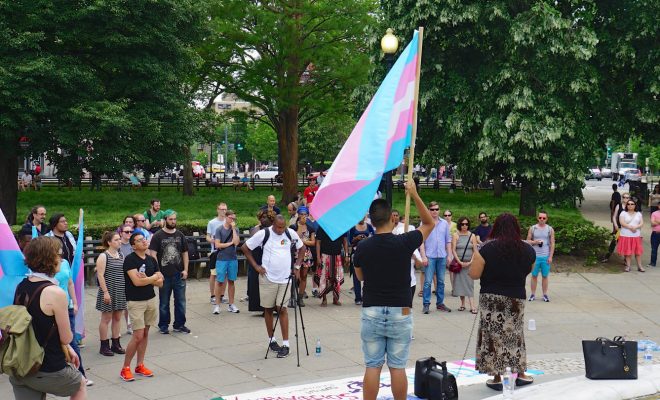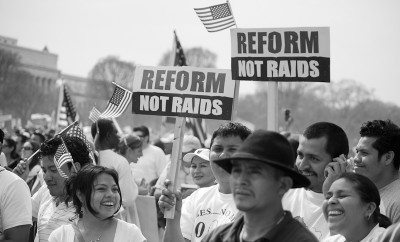 Image courtesy of [Ted Eytan via Flickr]
Image courtesy of [Ted Eytan via Flickr]
Law
The Language of Asylum Law: Obstacles for Transgender Asylum Seekers
Though positive changes are on the horizon for certain aspects of immigration law affecting transgender asylum seekers, the language that courts use to process transgender asylum cases extends beyond the letter of the law itself. The language with which courts deal with transgender individuals and issues can fundamentally prevent transgender asylum seekers from gaining safety in the United States.
How does the language of asylum courts impact the case law and outcomes of transgender asylum seekers?
Transgender Asylum Case Law: A Legal Overview
Asylum seekers who are lesbian, gay, bisexual, or transgender (LGBT) face particularly strong obstacles in their application processes. Some protections have been added to immigration case law that have increased protections for LGBT asylum seekers. In 1990, lesbian women and gay men gained protection under immigration law as a “particular social group” (PDF). This means that, in a similar way to how Title IX protects women from gender-based discrimination within the United States, lesbians and gay men became a likewise “protected” group that can be afforded asylum due to homophobic discrimination and violence in their countries of origin.
The dangers of language that is not trans-inclusive are extremely high for trans individuals seeking asylum. In 2000 and again in 2004, immigration courts recognized people that they term “gay men with female sexual identities” as a “particular social group,” therefore providing that these people can be granted asylum protections if they are persecuted for being a “gay male with female sexual identity” in their country of origin. However, courts misgender many asylum seekers when they label them as such; by refusing to acknowledge the chosen names and accurate (female) pronouns for transgender women seeking asylum, the courts only provide protection for trans women seeking asylum insofar as they are misidentified as “gay men with female sexual identities.” This invalidating language refuses to accept trans women’s status as women, and makes it very difficult for them to make it clear to the court that the violence they face in their country of origin is because of their identity. Because of this refusal to use trans-affirmative language, courts subject transgender asylum seekers to a great deal of added abuse. Sure enough, until very recently, the U.S. government locked up transgender women seeking asylum with men, leaving these women vulnerable to extreme abuse and violence. This violence mirrors the transphobic violence that asylum seekers were trying to flee.
Case Study: Hernandez-Montiel v. INS
Misgendering language in immigration courts does even more than creating an indirectly damaging environment. This language creates strong precedent for transgender individuals to lose their asylum cases because of the uncertainty that misgendering causes. Imprecise and inaccurate language in the court can create tremendous and unnecessary obstacles for advocating for transgender immigrants seeking asylum.
In the case of Hernandez-Montiel v. INS (2000), Hernandez-Montiel applied for asylum on the basis of being a “gay man with female sexual identity” who had suffered past persecution in Mexico. The BIA (Board of Immigration Appeals) denied the request. Hernandez-Montiel applied for asylum at age sixteen after being raped and harassed by police, and though this testimony was found to be credible, the BIA denied the asylum application because the Immigration Judge (IJ) identified Hernandez-Montiel’s social group as “homosexual males who wish to dress as a woman [sic],” which did not at the time qualify as a particular social group.
The 9th Circuit court overturned the BIA’s judgement, finding that “gay men with female sexual identities” such as Hernandez-Montiel, comprise a particular social group for the purposes of asylum cases, and that the sexual assaults that she experienced at the hands of police officers were “on account of” her membership in that group. The 9th Circuit decision also stated that “Geovanni is not required to prove that his persecutors were motivated by his sexual orientation to the exclusion of all other possible motivations.” Therefore, the court granted the asylum petition. This ruling is significant because it establishes the above-discussed precedent that “gay men with female sexual identities” who are persecuted on the grounds of this identity are eligible for protection under U.S. immigration law.
While this may seem like an unambiguous victory for trans women, this language causes a lot of confusion for advocates of transgender asylum seekers. For example, Lambda Legal–an advocacy organization for LGBT people–identified Hernandez-Montiel in a press release as an “effeminate gay man” and, in tandem with the courts, used male pronouns to refer to Hernandez-Montiel. However, specifically transgender advocacy organizations identified Hernandez-Montiel as a trans woman.
This language-based inconsistency and inaccuracy not only places Hernandez-Montiel and others at risk for being imprisoned incorrectly while awaiting decisions, but it ensures that transgender organizations cannot properly advocate for people who are being abused in the system.
Case Study: Reyes-Reyes v. Ashcroft
In a similar case four years later (2004), asylum applicant Reyes-Reyes–referred to by the court by her given name, Luis–was denied entry into the United States because of the extreme misgendering and refusal to acknowledge Reyes-Reyes’s status as a woman that continually manifested in the language of the court’s proceedings. In this 9th Circuit case, Reyes-Reyes, a citizen of El Salvador, applied for asylum, withholding of removal (so that she could stay in the United States longer, without being forced back to El Salvador), and relief under CAT (the Convention Against Torture) for fear of persecution based on Reyes-Reyes’s sexuality and gender expression. The Immigration Judge denied all of these applications, and the Board of Immigration appeals upheld these denials.
Reyes-Reyes fled El Salvador as a teenager 25 years ago for fear of persecution. The court characterizes Reyes-Reyes as “a homosexual male with a female sexual identity… Although Reyes-Reyes has not undergone sex reassignment surgery, he has a characteristically female appearance, mannerisms, and gestures… He has a ‘deep female identity’ and has gone by female names such as Josephine, Linda, and Cukita.” Using inappropriate male pronouns and insisting that Reyes-Reyes is gay instead of transgender, the court acknowledged that Reyes-Reyes has a history of being violently persecuted in El Salvador, having been kidnapped, raped, and beaten “because of his sexual orientation” at age 13. Reyes-Reyes told no one for fear of further brutality, and the Immigration Judge (IJ) focused deeply on this failure to report the crimes. The IJ determined that Reyes-Reyes had not established that the government of El Salvador, or anyone acting on the government’s behalf, would want to do Reyes-Reyes harm upon return. Because of this, it was ruled that Reyes-Reyes had failed to establish past persecution for the purposes of withholding of removal. Upon appeal to the BIA, Reyes-Reyes obtained pro bono representation and presented information from human rights organizations, government, and news sources detailing El Salvador’s hostile political and cultural climate “towards male homosexuals with female identity.” This information included an affidavit from an expert on Latin American culture. The BIA summarily affirmed the IJ’s denials.
The 9th Circuit court remanded these decisions, but not on the grounds that the court was wrong about Reyes-Reyes’s identity. Rather, the court remanded the Immigration Judge and Board of Immigration Appeals’ decisions to deny asylum due to incorrectly applied burdens of proof. This means that the legal precedents of misgendering Reyes-Reyes are still firmly established, including the assertion of her being a “male homosexual with female identity.”
In this case, too, Reyes-Reyes’s identity was interpreted differently by different sources because of the transphobic language used by the court to describe this asylum applicant. The LA Times identified Reyes-Reyes as a trans man, while the advocacy organization Immigration Equality identified Hernandez-Montiel as a trans woman.
Future of Trans Asylum Cases
Despite certain positive changes in immigration law regarding transgender asylum seekers, transgender detainees are still at extreme risk for abuse and violence while being detained in the U.S. Because of the courts’ transphobic language–the refusal to acknowledge the proper names and gender pronouns of transgender applicants, insisting on calling trans women “gay men with female sexual identities”–transgender asylum applicants are placed at increased risk of being denied asylum and being exposed to extreme violence.
Resources
Primary
Additional
Center for American Progress: The Plight of Gay and Transgender Women Seeking Asylum
Immigration Equality: Asylum Law Basics
Bitch Media: Crossing Borders: LGBT People in Immigration Detention Are Often Targets For Abuse
Advocate: Transgender Immigrants to be Detained According to Gender Identity
Fusion: Why Did the U.S. Lock Up These Women With Men?
Lambda Legal: Mexican Gay Man Seeking Asylum Appeals to the Ninth Circuit
Transgender Asylum Weekly: Hernandez-Montiel v. INS
FindLaw For Legal Professionals: Reyes-Reyes v. Ashcroft
LA Times: Transgender Man’s Case Tests U.S. Immigration Law








Comments